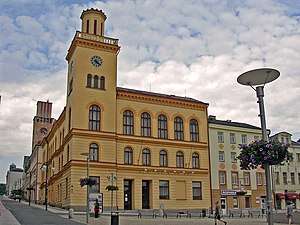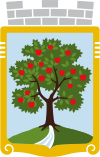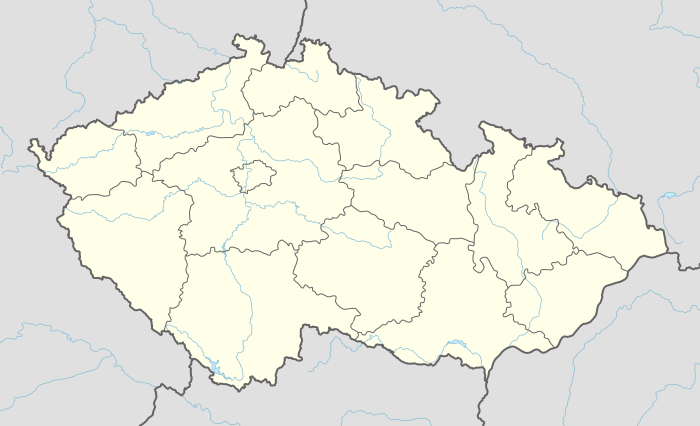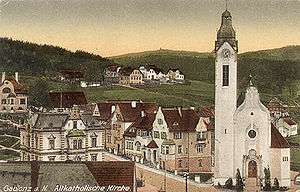Jablonec nad Nisou
Jablonec nad Nisou ([ˈjablonɛts ˈnad ɲɪsou] (![]()
Jablonec nad Nisou Gablonz an der Neiße | |
|---|---|
 Library (Old Town hall) | |
 Flag  Coat of arms | |
 Jablonec nad Nisou Location in the Czech Republic | |
| Coordinates: 50°43′28″N 15°10′5″E | |
| Country | |
| Region | Liberec |
| District | Jablonec nad Nisou |
| First mentioned | 1356 |
| Government | |
| • Mayor | Jiří Čeřovský |
| Area | |
| • Total | 31.39 km2 (12.12 sq mi) |
| Elevation | 475 m (1,558 ft) |
| Population (2020-01-01[1]) | |
| • Total | 45,773 |
| • Density | 1,500/km2 (3,800/sq mi) |
| Time zone | UTC+1 (CET) |
| • Summer (DST) | UTC+2 (CEST) |
| Postal code | 466 01 |
| Website | www.mestojablonec.cz |
Name
The village of Jablonec was first mentioned in a Latin document from 1356 (in nouo Jablonecz). The name Jablonec is of Czech origin and means "little apple tree" (jablonče was a diminutive of the old Czech jabloň – "apple tree"), for the village was founded on a place where an apple tree grew. German-speaking settlers who came to the village during the 16th century adjusted the In name to Gablonz. During the 19th century, the attribute "German" was often added to the name (like in the 1848 Czech: Jablonec německý, German: Teutsch-Gablonz). In 1904, the official attribute became "on the Neisse", which described the location of the town upon the river Lusatian Neisse (Czech: Jablonec nad Nisou, German: Gablonz an der Neiße).[2]
After the war, the expelled German-speaking citizens of Jablonec founded a new settlement in Bavaria and called in remembrance of their home town Neugablonz ("New Jablonec"). Today, it is one of the districts of the city of Kaufbeuren.
History
Jablonec was founded in the 14th century, according to the first written document which dates back to 1356. In August 1469, the village was burnt to the ground by troops of rebelling Lusatians in the war between them and King George of Bohemia. The village was then resettled during the 16th century by mostly German-speaking colonists.[2]
In the 18th century, the first artificial jewellery was produced and the first exporter, J. F. Schwan, spread the town's name throughout Europe. The village of Gablonz was declared a "market town" by Emperor Francis II on 21 April 1808 and was given full town status by Emperor Francis Joseph on 28 March 1866.

In the 19th century the town became prosperous and wealthy, as Gablonz traders seized the foreign markets. A steady supply of a wide range of glass and artificial jewellery products flowed out of the town. This industrial advancement also improved the quality of life, and Jablonec's appearance changed dramatically. However, Black Friday in 1929 damaged the glass and jewellery industry and the crisis of the 1930s with its unemployment and hunger led to great support of Nazis. In October 1938, Gablonz was occupied by Hitler's German Reich after the Munich Agreement, as a part of so-called Sudetenland. Before 1938, the population of Gablonz was composed of 86% German inhabitants, and the rest Czechs, Jews and many other groups. In Autumn 1938, most of the Jews, Czechs and anti-Nazi Germans escaped to other parts of Czechoslovakia and the Jewish synagogue was burned down. In May 1945, the town was liberated by the underground anti-Nazi groups together with some 700 French and Italian soldiers who were captives in Gablonz's camps.
Between 1945 and 1949, most of the Germans were expelled under the terms of Beneš decrees. However, a few thousand Germans who were active in struggle against the Nazi rule, Germans who had married Czechs, and Germans with special permits were allowed to stay home in Gablonz. Despite assimilation and emigration to Germany in 1968, the German minority in Gablonz still exists (there are some 1000–2000 in the town). With the exception of original Czech and Jewish Gablonz residents who returned to the area, many of the new Czech inhabitants of Gablonz came from nearby Czech towns and villages. Gablonz has also an important Greek minority, founded by Communist refugees of the Greek Civil War in 1949, and a minority of Roma. Some of the Germans expelled from Gablonz and its surroundings founded the quarter of Neugablonz near Kaufbeuren in Bavaria and a group in Enns in Upper Austria after 1950.
Present day
Jablonec is a centre of active holiday tourism and sport, with a swimming pool, three football and athletic stadiums, an ice hockey arena, 13 gyms, and 16 playgrounds. It is also well known for its modern architecture from the 1900s, 1920s, and 1930s. The Jablonec valley dam is the northern-most intra-urban valley dam in Europe.
Jablonec holds the Czech Mint (Česká mincovna) after Czechoslovakia split into the Czech Republic and Slovakia (the Czechoslovakian mint, also known as the Kremnica Mint, is now in Slovakia).
Jablonec shares the tramway line which connects it to its neighboring city, Liberec.
Sport
Football
The city is nowadays represented by FK Jablonec in the Czech First League.
Before the Second World War, a number of ethnic German football clubs existed in Gablonz, Fortuna, DSK and BSK. These were merged into NSTG Gablonz in 1939 by the Nazis, NSTG standing for Nationalsozialistische Turngemeinde. NSTG played in the Gauliga Sudetenland but disappeared with the end of the war.[3] BSK however was reformed in 1950 in Bavaria, under the name of BSK Neugablonz.[4] In 2009, a friendly is planned between the BSK and FK Jablonec in an attempt to improve contacts between Neugablonz and Jablonec nad Nisou.[5]
Notable people
- Adolf Benda (1845–1878), historian
- Gustav Leutelt (1860–1947), writer and poet
- Reinhold Hanisch (1882–1937), business partner of Adolf Hitler in Vienna, 1910
- Konrad Henlein (1898–1945), Nazi politician
- Peter Herman Adler (1899–1990), conductor
- Ute de Lange Nilsen (born 1931), Czech-Norwegian artist
- Jiří Moskal (born 1949), rally raid driver
- Jakub Čutta (born 1981), ice hockey player
- Barbora Špotáková (born 1981), javelin thrower
- Radka Vodičková (born 1984), triathlete
- Daniel Špaček (born 1986), ice hockey player
- Gabriela Koukalová (born 1989), biathlete
- Markéta Davidová (born 1997), biathlete
Twin towns – sister cities
Jablonec nad Nisou is twinned with:[6]





.svg.png)

References
- "Population of Municipalities – 1 January 2020". Czech Statistical Office. 2020-04-30.
- Lutterer, Ivan; Majtán, Milan; Šrámek, Rudolf (1982). Zeměpisná jména Československa. Praha: Mladá fronta. p. 129.
- Grüne, Hardy (2001). Vereinslexikon. Kassel: AGON Sportverlag ISBN 3-89784-147-9
- Historie - Chronik des BSK Olympia Archived 2011-07-18 at the Wayback Machine (in German) BSK Neugablonz website - History, accessed: 9 July 2009
- Freundschaftliche Bande Archived 2011-07-19 at the Wayback Machine (in German) Kreisbote - Local newspaper, published: 5 June 2009, accessed: 9 July 2009
- "Partnerská města" (in Czech). Statutární město Jablonec nad Nisou. Retrieved 2020-06-22.
External links
| Wikimedia Commons has media related to Jablonec nad Nisou. |
- (in Czech) Municipal website
- (in Czech) Guide-Book of Jablonec nad Nisou
- (in English) City theatre
- (in English) City theatre
- (in English) Gablonzer Cooperation of all jewellery manufacturers
- (in German) Gablonz's postcards
- (in Czech) Gablonz's postcards
- (in English) Czech bead manufacturer